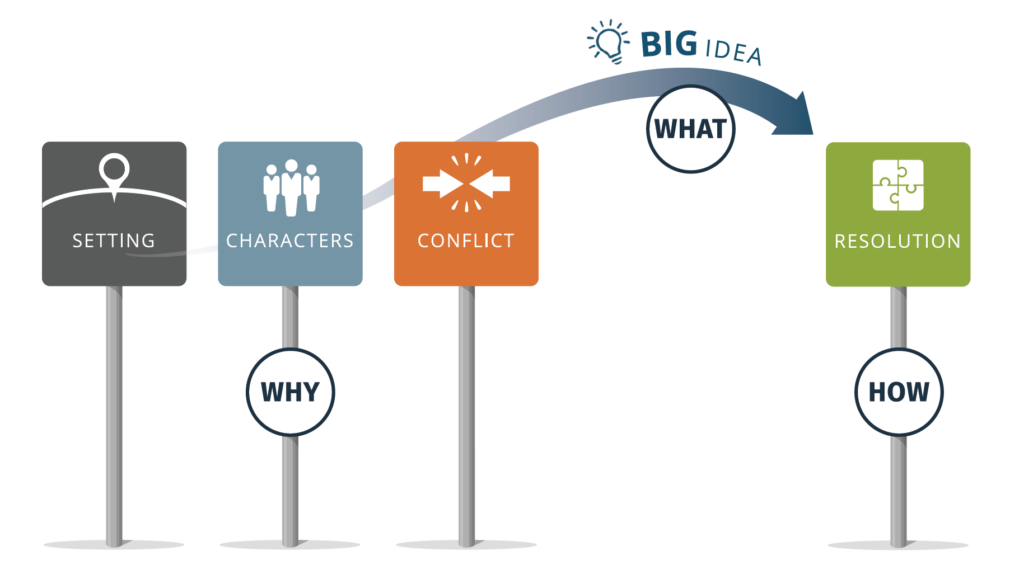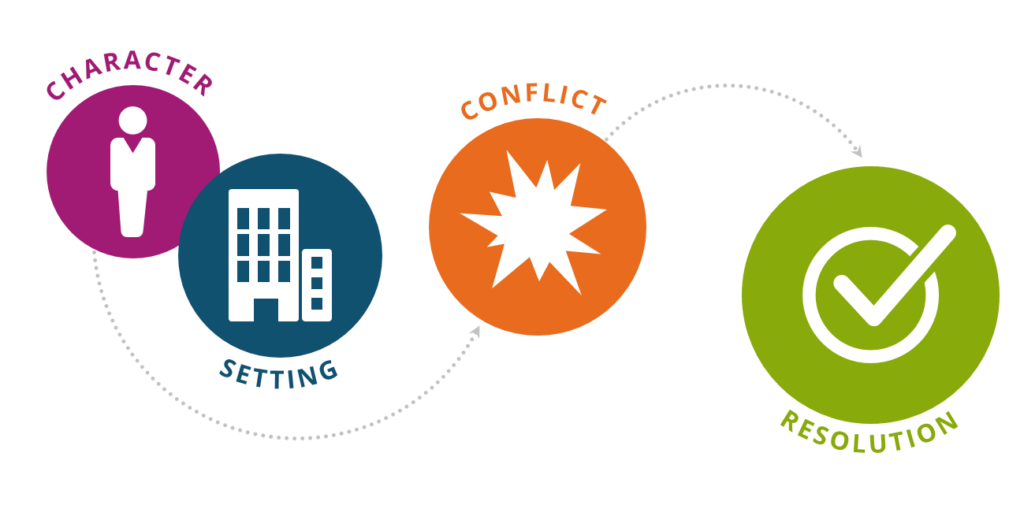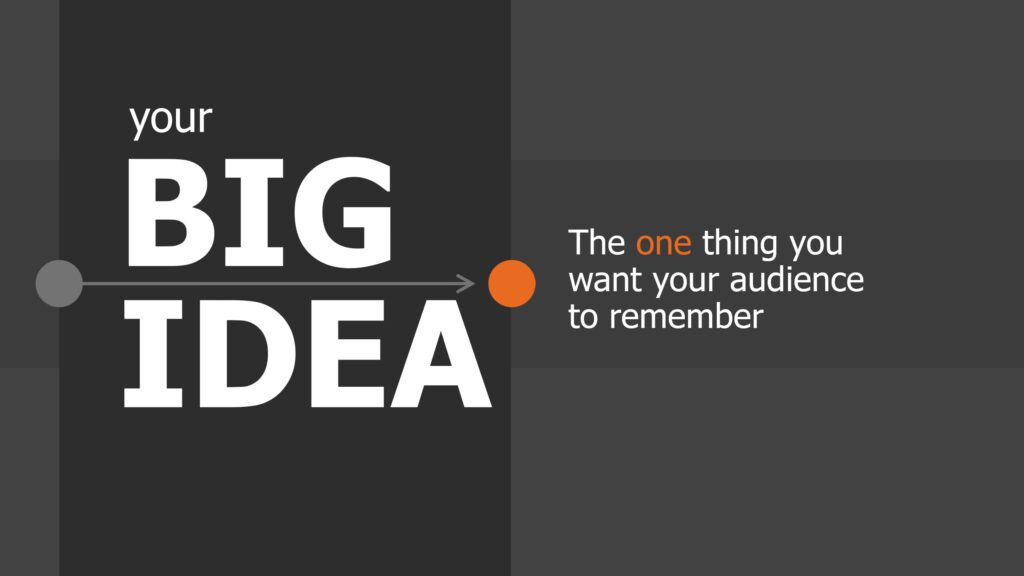According to Antonio Damasio’s book “Descartes’ Error: Reason, Emotion and the Human Brain,” neuroscience tells us that humans respond more powerfully to stories than plain facts or data alone. We don’t need an advanced degree to understand this concept, though. We already know (and feel) that the most thoughtful, powerful and exhilarating leaders present in the language of story. Yet, structuring our business presentations into stories remains one of our greatest struggles.
What do we do instead? Think back to your last meeting. Was it filled with a litany of dry, bulleted facts? Were you overwhelmed with mountains of data? Did the presenter drone on in a colorless monologue? The reality is that most of us – even smart and talented people – present this way.
How do we stop these mind-numbing performances? It’s simple: Structure data and facts into a narrative that follows the classic arc of storytelling you find in great books, movies and plays. Using story structure – including setting, character, conflict and resolution – in business communications will take your audience on an emotional journey, making your ideas much more memorable.
A Storytelling Framework Jumpstarts Your Presentation

Preparing a story-driven presentation is much less bewildering if you have a framework to help you organize your thoughts, facts and data into a logical flow. A framework should guide you in three areas: your audience, your story arc and your big idea. All three of these exercises are performed before you build your first slide. This prep work ultimately saves time, because it makes the visual part of your presentation much more intuitive.
First, Take a Walk in Your Audience’s Shoes
We know generally whom we are presenting to, but a deeper understanding of our audience is often lacking. It cannot be overstated how important it is to know:
- What is happening in your audience’s world? What challenges or obstacles are they facing?
- Who or what matters to your audience?
- What is their current mindset?
If you are hoping to change people’s mindsets and convince them to accept your recommendations, it helps immensely to know the answers to these questions. This is also the time to imagine what’s at stake for your audience if they reject your ideas. It will point you to which supporting data or facts to include to build the foundation for your argument.
Piece Together Your Story

What do “Game of Thrones,” “War and Peace,” or “Superman” have in common with your story-driven presentation? They all contain the four signposts of classic storytelling:
- Setting: Your setting is a snapshot in time, a place or a circumstance. It immediately establishes the context for your message.
- Characters: Your characters are who or what is affected by the current situation — your customers, employees or team. Characters help your audience relate to your story.
- Conflict: With the context of setting and characters in place, it’s time to reveal the conflict. Conflict provides the tension that gives your audience a reason to care.
- Resolution: With setting, characters and conflict established, your audience’s emotions will be built up. They will hopefully be ready to embrace your resolution – your recommendation, product or solution.
If you’ve accurately analyzed your audience and established a clear setting, characters and conflict, your audience will be much more likely to care about your resolution. You can begin to weave together your supporting facts and data as they serve to advance your story. Business storytelling requires you to take your audience on both an emotional and a logical journey.
Make Sure You Always Have a Big Idea

Your story framework should guide you through the identification of your big idea – the key takeaway of your story. If your audience only remembers one thing about your presentation, it’s this lynchpin idea that serves as the purpose and guide for every one of your other ideas. If any of your facts or data fail to make an obvious connection to your big idea, they should likely not be included in your presentation.
It’s helpful to think of your presentation as a combination of “why,” “what” and “how” messages. The setting, character and conflict are the “why” (giving us a reason to care). Your Big idea is the “what” (it should address the conflict and tease the resolution). Finally, your resolution is the “how” (i.e., what is your detailed solution to resolving the conflict?) Your big idea is usually revealed early and repeated throughout your story. Be sure not to confuse it with your resolution.
Bring Your Story to Life Visually
Think of your story like building a house. Your story arc and your big idea are the infrastructure; you have rooms, the walls are in place and you have your supporting beams. Adding visuals is your chance to create aesthetic finishes. It’s your paint, carpet and lighting. Clever visual design, including photos, diagrams, charts, text or video, will turn up the emotional volume on your story. Three of the most engaging visual techniques are:
- Photos of people: Photos of people bring emotion to your story when used appropriately. Audiences (made up of people) are programmed to respond to pictures of other people.
- Callouts: The absolute go-to for great data visualization, callouts use color, size and shape to instantly draw your audience’s focus to your key points.
- Infographics, icons and oversized text: These simple visual aids help you “think outside the spreadsheet” to highlight critical data points and illustrate your story. They go well beyond the standard (overused) charts, tables and bulleted text.
We all tell stories every day, but to become stronger, more strategic presenters, it’s time to bring stories inside the office. The key is to use a framework that will guide you to understand your audience, craft a big idea and architect a story structure. With this roadmap, anyone can build a narrative that leads with story, not just endless facts and data.
As great presenters already know, storytelling isn’t just about an entertaining show for the audience. It is a method that will significantly improve the impact you will have on the executives, customers and partners you face every day.
REPRINTED WITH PERMISSION FROM TRAININGINDUSTRY.COM
